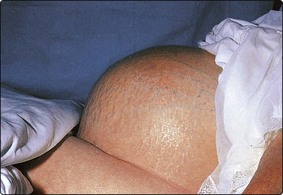64 Ascites is fluid in the peritoneal space. It can usually be detected by clinical examination (Fig 64.1). Laboratory analysis of ascitic fluid may provide answers to important clinical questions, as its composition varies depending on the underlying cause. The serum-ascites albumin gradient (SAAG) is defined as the serum albumin concentration minus the ascitic fluid albumin concentration. The SAAG correlates directly with the portal pressure. Patients with a wide SAAG (defined as ≥11 g/L) have portal hypertension, whereas patients with a narrow SAAG (<11 g/L) do not (Table 64.1). Table 64.1 Serum-ascites albumin gradient
Ascites and pleural fluid
Ascites
Serum-ascites albumin gradient
Wide (>11 g/L)
Narrow (<11 g/L)
Chronic liver disease (cirrhosis)
Peritoneal carcinomatosis
Veno-occlusive disease
Reduced plasma oncotic pressure (e.g. nephrotic syndrome)
Massive hepatic metastases
Secondary peritonitis
Congestive cardiac failure
Tuberculous peritonitis
Spontaneous bacterial peritonitis
Ascites and pleural fluid




